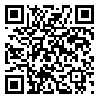Tue, Dec 16, 2025
[Archive]
Volume 13, Issue 1 (3-2023)
J Adv Biomed Sci. 2023, 13(1): 40-56 |
Back to browse issues page
Download citation:
BibTeX | RIS | EndNote | Medlars | ProCite | Reference Manager | RefWorks
Send citation to:



BibTeX | RIS | EndNote | Medlars | ProCite | Reference Manager | RefWorks
Send citation to:
Barati B, Kaydani M, Ahmadpour F, Kalantar M, Farhadi Birgani F. The Comparative Evaluation of Hospitalized Elderly Patients with COVID-19 from the Onset of the Disease to Recovery and Death in Iran. J Adv Biomed Sci. 2023; 13 (1) :40-56
URL: http://jabs.fums.ac.ir/article-1-2731-en.html
URL: http://jabs.fums.ac.ir/article-1-2731-en.html
Barat Barati1  , Masoumeh Kaydani2
, Masoumeh Kaydani2  , Fatemeh Ahmadpour3
, Fatemeh Ahmadpour3  , Mojtaba Kalantar2
, Mojtaba Kalantar2  , Fariba Farhadi Birgani *4
, Fariba Farhadi Birgani *4 
 , Masoumeh Kaydani2
, Masoumeh Kaydani2  , Fatemeh Ahmadpour3
, Fatemeh Ahmadpour3  , Mojtaba Kalantar2
, Mojtaba Kalantar2  , Fariba Farhadi Birgani *4
, Fariba Farhadi Birgani *4 
1- Department of Radiologic Technology, Shoushtar Faculty of Medical Sciences, Shoushtar, Iran
2- Department of Occupational Health, Shoushtar Faculty of Medical Sciences, Shoushtar, Iran
3- Department of Clinical Biochemistry, Ahvaz university of Medical Sciences, Ahvaz, Iran
4- Department of Radiologic Technology, Shoushtar Faculty of Medical Sciences, Shoushtar, Iran ,farhadi.f92@gmail.com
2- Department of Occupational Health, Shoushtar Faculty of Medical Sciences, Shoushtar, Iran
3- Department of Clinical Biochemistry, Ahvaz university of Medical Sciences, Ahvaz, Iran
4- Department of Radiologic Technology, Shoushtar Faculty of Medical Sciences, Shoushtar, Iran ,
Abstract: (2337 Views)
Background & Objectives: Numerous studies have shown that the risk of death is higher in elderly patients with COVID-19. In Iran, due to the growth of the elderly population and the prevalence of underlying diseases, it is necessary to pay attention to this age group of patients. In this study, clinical, radiological, PCR, and laboratory data of elderly patients with COVID-19 were collected and analyzed in two groups of recovered and dead patients.
Materials & Methods: This is a retrospective study of 196 consecutive elderly patients with COVID-19 hospitalized from March 21, 2020, to April 3, 2020, and their follow-up until April 23, 2021. Clinical characteristics, laboratory results, PCR, chest CT scans and Hounsfield Unit data were collected and analyzed in two groups of recovered and dead patients. Obtained Data were analyzed using SPSSv22.0 and MATLAB-R2017 software.
Results: The results showed that there were no specific symptoms to distinguish the death group from the recovery group. Significant differences were observed between the two groups for red blood cell counts, hemoglobin, MCHC and MCV levels, bilirubin, aminotransferase levels, CRP, white blood cells, serum BNU, creatinine and PT coagulation index. The concentrations of VBG (HCO3) and VBG (PCO2) in the deceased patients suggest compensated respiratory alkalosis. CT sensitivity is 100% for patients in advanced and severe stages of the disease.
Conclusion: The patients in the death group had more underlying diseases than the recovered group. COVID-19 patients are more likely to die when they have both diabetes and cardiovascular disease.
Materials & Methods: This is a retrospective study of 196 consecutive elderly patients with COVID-19 hospitalized from March 21, 2020, to April 3, 2020, and their follow-up until April 23, 2021. Clinical characteristics, laboratory results, PCR, chest CT scans and Hounsfield Unit data were collected and analyzed in two groups of recovered and dead patients. Obtained Data were analyzed using SPSSv22.0 and MATLAB-R2017 software.
Results: The results showed that there were no specific symptoms to distinguish the death group from the recovery group. Significant differences were observed between the two groups for red blood cell counts, hemoglobin, MCHC and MCV levels, bilirubin, aminotransferase levels, CRP, white blood cells, serum BNU, creatinine and PT coagulation index. The concentrations of VBG (HCO3) and VBG (PCO2) in the deceased patients suggest compensated respiratory alkalosis. CT sensitivity is 100% for patients in advanced and severe stages of the disease.
Conclusion: The patients in the death group had more underlying diseases than the recovered group. COVID-19 patients are more likely to die when they have both diabetes and cardiovascular disease.
Type of Study: Research |
Subject:
Radiology
Received: 2021/10/18 | Revised: 2023/04/24 | Accepted: 2023/01/18 | Published: 2023/04/24
Received: 2021/10/18 | Revised: 2023/04/24 | Accepted: 2023/01/18 | Published: 2023/04/24
Send email to the article author
| Rights and permissions | |
 |
This work is licensed under a Creative Commons Attribution-NonCommercial 4.0 International License. |

This work is licensed under a Creative Commons — Attribution-NonCommercial 4.0 International (CC BY-NC 4.0)




